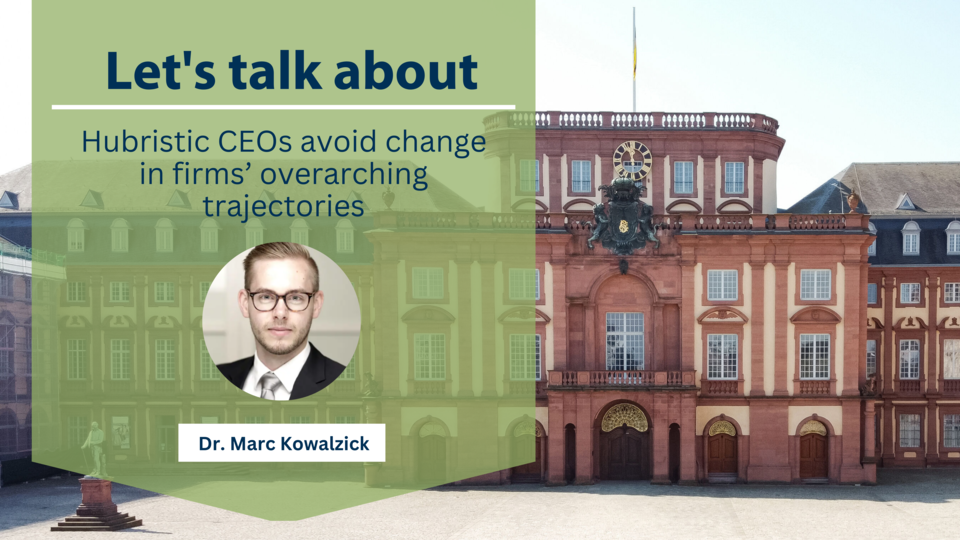Hubristic CEOs avoid change in firms’ overarching trajectories

Hubristic CEOs avoid change in firms’ overarching trajectories
Marc Kowalzick, Post-Doctoral researcher at the University of Mannheim, Business School
The term hubris originates from Greek mythology and was considered as man’s capital sin. As such, hubris lead humans to challenge the gods, often leading to downfall or punishment, a theme common in many Ancient Greek tales. Therefore, excessively confident, presumptuous, blindly ambitious, or otherwise lacking humility persons were struck down by the gods in Greek myths. Think of Arachne being turned into a spider by the goddess Athena after claiming her weaving was superior, or Icarus flying too close to the sun.
In modern times, the term has evolved, referring more to one’s excessive self-confidence and an overestimation of their abilities. As such, hubris can manifest in an individual’s decision-making processes, with more hubristic individuals standing out amongst their peers, but also preventing them from recognising their limitations and boundaries.
In our work we use the definition of Webster’s Dictionary that describes hubris as “exaggerated pride or self-confidence, often resulting in retribution.”
But what happens when overly self-confident individuals reach positions of power, such as the CEO post?
Alongside Moritz Appels, former doctoral student at the University of Mannheim and now Assistant Professor at Rotterdam School of Management, Erasmus University, we investigated whether hubristic CEOs are inclined to change or not to change their firms’ overarching trajectories.
We utilized a panel dataset of around 1200 S&P CEOs, measuring their levels of hubris and assessing well-established indicators for strategic and social change: change in resource diversification, business segment change, corporate restructuring, and top management team (TMT) membership change. The TMT refers to CEOs’ closest executive peers, each of whom CEOs engage with regularly and intensively.
We found that CEO hubris leads to less strategic change and TMT membership change within the organisation. Therefore, a more hubristic CEO’s inflated self-assessment manifests not only through their pursuit of challenging strategic activities, that is well documented in the literature, but also in a preference for steadiness regulating their impact on firms’ overarching trajectories.
In fact, previous research suggests that more hubristic CEOs are regularly attracted to challenging strategic activities, uncertain investments, bold innovation projects, and risk product introductions, and are more likely to engage in acquisitions.
Therefore, considering the results of these previous studies, our findings suggest that this preference for challenging strategic activities does not carry over to the pursuit of higher-order changes to a firm’s strategy and TMT. Much to the contrary, CEOs with inflated self-confidence seem to exhibit a preference for steadiness when it comes to firms’ overarching trajectories.
A reason behind this could be that CEOs with high levels of hubris see little reason to scrutinise and adapt existing organisational paths under their leadership. They consider themselves to be able to master the already established ways of doing things, even.
Therefore, although more hubristic CEOs might pursue challenging strategic activities for, they refrain from the pursuit of big organisational changes, such as corporate reorganizations, resource deployments to business units, or the firm’s TMT composition.
These findings have implications for research on strategic management and organisation science. Firstly, they contribute to upper echelons research by resolving the question of whether hubristic CEOs prefer change or steadiness as well as by highlighting both strategic change and TMT membership change as central mechanisms through which hubristic CEOs impact their firms. Upper echelons theory is a management theory which states organisational outcomes are partially predicted by managerial background characteristics of the upper-level manager.
This study also extends research on strategic leadership and managerial biases by representing the tenets of CEO hubris more holistically. Specifically, demonstrating that more hubristic CEOs remain steady with regard to firms’ strategic orientation and TMT composition, even though they are prone to pursue major strategic activities, contradicts the assumption that these activities will definitely result in changes in a firm’s overarching trajectories.
Building on this study, future research could investigate how our findings benefit the design of CEO incentive systems. Considering their inherent risk-affinity when it comes to the pursuit of challenging strategic activities, the key challenge in incentivising more hubristic CEOs might not be to counter misplaced risk.
Designing incentive systems that regulate hubristic CEOs’ preference for steadiness, while acknowledging their inherent tendency to pursue risky strategic activities, appears to be a useful application of our findings when it comes to CEO compensation.
In summary, our results support the notion that a preference for steadiness should be considered a major aspect of CEO hubris.